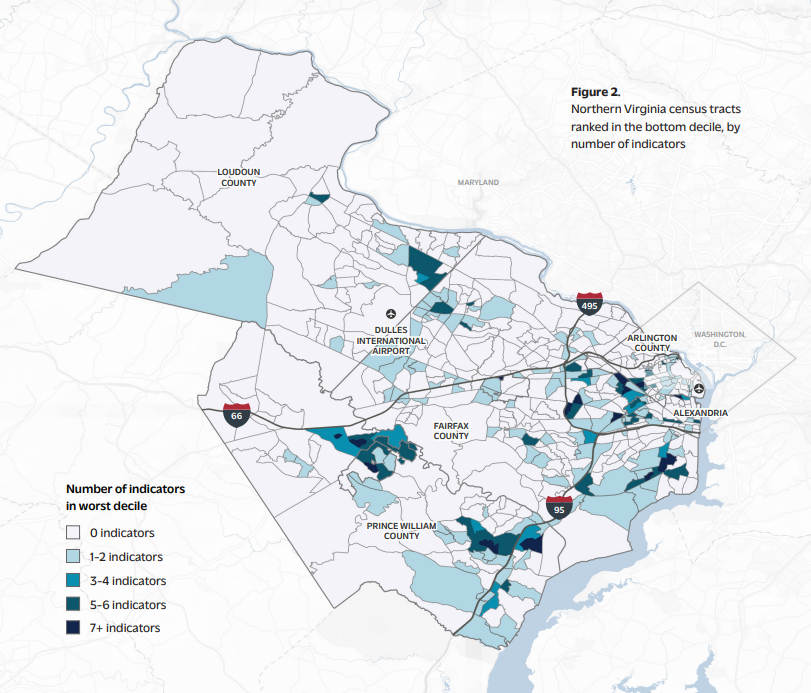In between the sprawling lawns of Loudoun County and the riverside lofts of Alexandria lie clusters of struggling, predominantly non-white neighborhoods that are increasingly left out of the success and prosperity experienced by Northern Virginia as a whole, recent research notes.
In fact, conditions in some of those neighborhoods — called “islands of disadvantage” — have been in decline for years.
According to a new report by the Center on Society and Health at Virginia Commonwealth University, poverty, rates of people without health insurance, educational attainment, job opportunities and overcrowding all worsened in those neighborhoods between 2013 and 2021.
At the same time, the report notes the economic progress seen in some areas was also accompanied by gentrification and displacement of people of color.
“What is otherwise a healthy and wealthy area is also home to areas of concentrated disadvantage,” said Dr. Steven Woolf, lead author of the VCU report. “This is not something that is widely known, that people are living in deep poverty just a short distance away from the McMansions and golf courses.”

The report, “Lost Opportunities: The Persistence of Disadvantaged Neighborhoods in Northern Virginia,” compares census data from 2009-13 and 2017-21 for Arlington, Fairfax, Loudoun and Prince William counties and the city of Alexandria to understand the social and economic changes the region has experienced over time.
The report, commissioned by the Northern Virginia Health Foundation, builds upon previous research led by Woolf that showed the disproportionate amount of non-white residents that make up struggling neighborhoods experience substantially higher rates of premature death compared to Northern Virginia as a whole.
The latest research found that between 2009-13 and 2017-21, 92% of Northern Virginia census tracts saw an increase in median income, 73% had a rise in residents with a bachelor’s degree and 59% experienced gains in the proportion of adults with a high school diploma. Poverty and uninsured rates decreased in 52% and 78% of the region’s census tracts, respectively.
However, some “islands of disadvantage” experienced opposite trends during those time periods. One section of Bailey’s Crossroads in Fairfax County saw median household income decrease by about $10,000, child poverty rates nearly double to 63% and the overall poverty rate climb to 30%.
In one census tract in the Bull Run area of Prince William County where the Hispanic population increased by 53% while the white population fell by 38%, median household income increased by only $2,140, the poverty rate increased by 60% and overcrowded housing increased by 187%.
While some struggling neighborhoods saw a slight increase in median household income, Woolf said those gains have not risen proportionately to keep up with the cost of inflation.
“It’s not enough to keep people out of poverty,” Woolf said. “We live in a time with rising health care costs, rising costs for child care and inflation that’s causing increased prices for food and other necessities.”
At the same time, economic progress in some areas was accompanied by increases in the size of the white population, suggesting gentrification and displacement of people of color may have also been underway.
Researchers pointed as one example to the Courthouse area of Arlington County, where median household income increased from $87,233 to $132,603 and the poverty rate plummeted from 19% to 5%. However, at the same time the share of the population that was white grew from 48% to 68%, while those of the Black and Asian populations declined by 42% and 72%, respectively. Similar displacement trends were also seen in Old Town Alexandria, areas of Annandale and the historically Black neighborhood of Green Valley/Nauck.
SUPPORT NEWS YOU TRUST.
The report said it is unclear if the relief programs instituted in response to the COVID-19 pandemic, like economic assistance and eviction moratoriums, accounted for some of the progress seen in certain areas, like increases in median income — or if that progress was only temporary.
While some might argue that economically struggling Northern Virginia residents should move away from an area where the cost of living is so high, Woolf said it’s not that simple. Not only is moving unaffordable for many of these families, Woolf said, but “economists and others have shown that regions thrive when there is diversity and when there is equity and opportunity across the population.”
“So systematically displacing low-income families and people of color from a region is not a healthy strategy for trying to give an opportunity for everyone to thrive,” he said.
Moving forward, Woolf said policymakers need to invest more into marginalized communities and commit resources to improve their living conditions and health.
Fairfax County Board of Supervisors Chair Jeff McKay said the county’s One Fairfax Policy, which was passed in 2016 with the intent of combating racial and social disparities seen in some neighborhoods, aims to address many of the problems identified in the study.
“Whether it be through building more affordable housing units, creating more public transit options, or fully funding our school budget, we are constantly working towards breaking cycles of poverty and expanding our resident’s access to basic needs,” McKay said in an email.

